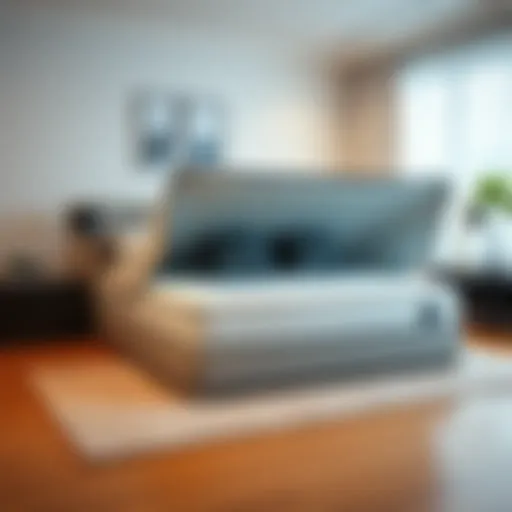Exploring Collapsible Wooden Dining Tables: Style Meets Utility


Intro
In nowadays fast-paced world, the way we design our homes often reflects our need for flexibility and functionality. One piece of furniture that exemplifies this is the collapsible wooden dining table. These tables, merging functionality with aesthetic appeal, cater to various lifestyles, making them a popular choice for homes, apartments, and even outdoor gatherings. Throughout this article, we will explore the remarkable versatility of collapsible wooden dining tables, looking into their design features, practical applications, and how they can enhance a living space with both style and utility.
Furniture Trends
Collapsible wooden dining tables are increasingly becoming a staple in contemporary homes. Their adaptability allows them to seamlessly blend into various design schemes while providing impressive space-saving solutions. Let's dig a bit deeper into the current market trends and popular styles surrounding these tables.
Current Market Trends
As urban living spaces become smaller, the demand for multipurpose furniture has surged. The collapsible wooden dining table fits perfectly into this trend, capturing the attention of homeowners looking for both form and function. Here are a few market trends to note:
- Sustainable Material Choices: Many consumers are leaning towards eco-friendly woods, such as bamboo and reclaimed timber, to not only enhance the aesthetic but also reduce their ecological footprint.
- Minimalist Designs: Simple lines and clean silhouettes dominate the scene. Collapsible tables are often designed with a minimalist approach, making them a stylish addition to any dining area.
- Customization Options: Some manufacturers offer tables that can be personalized, allowing buyers to choose sizes, finishes, and shapes that best fit their needs.
Popular Styles and Designs
Diversity in design means there's a collapsible wooden dining table suited for every taste. Here are several styles that stand out today:
- Scandinavian Style: Characterized by light woods, neutral colors, and functional designs, this style emphasizes simplicity and efficiency.
- Industrial Style: Featuring rough textures and metal accents, industrial tables can pair with a variety of decor while adding an edgy feel to the space.
- Farmhouse Chic: Rugged, rustic designs embody warmth and comfort, often incorporating elements like distressed wood and elegant curves.
- Modern Contemporary: With sleek surfaces and innovative mechanisms, these tables often include built-in extensions that make transforming the space easy and convenient.
"Collapsible wooden dining tables are not just furniture; they are a reflection of modern living, seamlessly accommodating personal aesthetics while offering practical solutions."
In synthesizing various aspects of collapsible dining tables, we see that they are far more than merely practical pieces of furniture. Their presence in our homes reflects a commitment to sustainable living, aesthetic values, and adaptability. Each design tells a story of how we choose to interact with our environment, underscoring the importance of thoughtful design in our furniture selections.
We will now turn to practical applications and DIY projects for those eager to explore this versatile furniture option further.
Prelude to Collapsible Wooden Dining Tables
Collapsible wooden dining tables are not just furniture; they embody the very essence of modern living. As our homes have evolved into multi-functional spaces, the demand for versatile, space-saving solutions has surged. These tables can seamlessly transform from a small gathering spot to a large dining area, accommodating guests without cramping your style. By effortlessly blending design with functionality, collapsible wooden dining tables present a unique solution for varying needs, whether you're a homeowner or someone renting a tiny apartment.
Defining Collapsible Tables
Collapsible tables, at their core, serve one primary purpose: adaptability. These are tables that can be folded down, expanded, or adjusted in size, making them suitable for both everyday use and special occasions. Imagine hosting a dinner for friends, then swiftly transforming the space back to its normal state for a quiet evening. The beauty lies in their design which allows for this transition.
When we talk about collapsible wooden dining tables, it’s essential to note that they come in various forms, from traditional foldable designs to more intricate mechanisms that allow for extension. Each style comes with its own set of benefits and limitations, typically revolving around aesthetics, ease of use, and sturdiness.
Historical Context
Examining the roots of collapsible tables reveals a fascinating journey through time. While the concept of a portable table goes back to ancient civilizations, where functionality often dictated design, today's versions lean heavily on both practicality and artistry. Early wooden tables used for military campaigns or trade often had hinged designs for easy transport.
In the mid-20th century, constraints on space and shifts in lifestyle observed during urbanization fostered the development of collapsible models tailored for smaller living spaces. As cities grew and home sizes shrank, tables that could easily be stored became indispensable.
Fast forward to the present, and the blend of craftsmanship with modern materials has led to a renaissance of collapsible wooden tables. There’s a strong emphasis on not just maintaining utility, but also enhancing curb appeal, allowing them to fit seamlessly into both traditional and contemporary decor. The historical evolution underlines a crucial point: collapsible wooden dining tables are more than mere furniture; they are reflective of societal changes and the ever-evolving concept of home.
"In the world of design, it’s not about making statements, but rather finding solutions that blend seamlessly into daily life."
Understanding the importance of collapsible wooden dining tables sets the stage for exploring their key advantages, material choices, and design considerations. By navigating this path, we can appreciate how these tables not only serve a purpose but also enhance the overall aesthetic of modern living.
Key Advantages of Collapsible Designs
The rise of collapsible wooden dining tables is more than just a design trend; it reflects the transition towards smarter living spaces. As urbanization continues and homes shrink, the need for multipurpose furniture becomes paramount. Collapsible designs stand out for several reasons, merging functionality with style in ways that captivate homeowners, designers, and anyone interested in making the most of their space.
Space Efficiency
In a world where square footage often comes at a premium, the utility of collapsible tables cannot be overstated. These tables are crafted with an eye for maximizing available room, accommodating anything from a small studio apartment to a grand dining space, all while being unobtrusive.
Consider this: folding tables allow you to transform your space within minutes. A dining area can shift to a cozy game night setup or an extra workspace without a hitch. Their compact structures mean you can easily tuck them away when not in use. For instance, a collapsible wooden dining table that folds down can fit in a closet, unlike traditional bulky tables that often claim significant permanent floor space.
"A cleverly designed collapsible table can redefine the way you think about your living space, making it feel larger and more versatile."
Flexible Use for Various Occasions
Think of the gatherings you might have – from family dinners to small buffet-style brunches to casual coffee chats. Collapsible wooden dining tables adapt to the vibe of the occasion. With a simplistic mechanism, these tables can extend or reduce their size, catering to variations in guest numbers and activities.
The beauty of such tables lies in their ability to shift character. A beautifully finished wooden table can gracefully transition from an everyday dining piece to a stunning centerpiece for a party. It can easily fit into any interior decor, be it modern, rustic, or minimalistic. Their functionality doesn't just accommodate physical needs; it also reflects the user’s aesthetic preferences, achieving a harmonious balance between utility and elegance.
Ease of Storage
Storage can be a headache, particularly in smaller homes. Collapsible wooden dining tables excel in this area, as they can be effortlessly folded and stored away when not in use. This is where they shine in comparison to traditional dining setups.
Imagine hosting a large gathering and, once the festivities wrap up, you can quickly fold the table and slide it under a bed or into a corner until the next event. This ease of stashing away means you don't have to suffer clutter; rather, your living space remains airy and open.


In summary, collapsible designs offer homeowners a range of essential benefits, including:
- Space-saving features that help utilize rooms efficiently.
- Versatility for various celebrations and everyday needs.
- Convenience in storage, guarding against clutter.
These advantages illustrate that collapsible wooden dining tables are not merely a practical solution, but a vital part of modern home design philosophy.
Material Choices in Wooden Dining Tables
When choosing a collapsible wooden dining table, material selection plays a pivotal role in both its longevity and overall look. The type of wood not only dictates the table's durability and functionality but also influences the aesthetic appeal and environmental impact of the furniture. Understanding the nuances of various materials allows homeowners and designers to make informed decisions that align with their design vision and practical needs.
Types of Wood Commonly Used
Hardwood Considerations
Hardwoods such as oak, maple, and cherry have long been the gold standard in furniture making, and for good reason. Their dense structure provides the necessary stability while boasting a beautiful grain pattern that adds character to any dining area. A significant aspect of hardwoods is their durability; these materials can withstand daily use and resist wear over time.
Besides their robust nature, hardwoods also offer a certain timeless elegance that softwoods simply can't match. However, they come with a higher price tag, which may not fit every budget. It's worth noting that hardwood tables require proper care to maintain their finish, adding an additional layer of consideration for potential buyers.
Softwood Options
Softwoods such as pine and cedar are often seen as more budget-friendly alternatives to their hardwood counterparts. One of the main advantages of softwoods is their lightweight nature, which makes them easier to move and set up—an appealing feature for collapsible designs.
Moreover, softwoods have a natural charm and warmth that can complement more casual decor styles. However, they are generally less resilient than hardwoods, and this results in a greater potential for dents and scratches. Understanding these trade-offs is vital when choosing the right material for your needs.
Engineered Wood Alternatives
Engineered wood refers to products like plywood and particle board, often crafted from the remnants of other wood processing. These materials provide an eco-friendly choice due to their efficient use of resources and lesser environmental footprint compared to solid wood options.
A critical characteristic of engineered wood is its consistency. Unlike natural wood, it’s less prone to warping and cracking, which makes it easier to maintain over the long haul. However, engineered wood may lack the premium feel and aesthetic appeal of solid wood, leading some to question its long-term value in high-end design applications.
Finish Techniques and Their Impact
Choosing the right finish is essential not only for aesthetics but also for protecting the table from spills, scratches, and other wear over time. The finish impacts the table's appearance and its ability to withstand everyday challenges.
Natural Finishes
Natural finishes, which typically involve oils and waxes, allow the wood to retain its unique character while providing a moderate level of protection. One primary advantage of this approach is that it enhances the grain pattern, showcasing the beauty of the wood.
However, natural finishes may require more frequent reapplication to maintain their effectiveness against damage and fading. This brings about the consideration of labor and ongoing care that homeowners will need to invest.
Acrylics and Polyurethanes
Acrylic and polyurethane finishes offer high durability and are often preferred in high-traffic environments where spill resistance is a consideration. The gloss from such finishes can be visually stunning, imbuing the table with a polished appearance that appeals to modern tastes.
On the downside, these finishes may obscure the natural look of the wood's grain pattern, which can disappoint buyers seeking that organic charm. Additionally, some people find the chemical smell of these products off-putting during application.
Painted Surfaces
Painted finishes open the door to infinite customization options. Whether you prefer a bold and vibrant table or a soft, muted look, paint can transform a wooden table to fit any decor style. The versatility offered by this method makes it an attractive option to pair with unique design aesthetics.
Of course, painted surfaces come with their own set of challenges. Over time, paint can chip or wear, requiring touch-ups or complete refinishing to maintain its appearance. Buyers must weigh these considerations as they think about long-term maintenance involved with painted wooden tables.
In summary, material selection and finishing techniques profoundly affect the functionality and aesthetic of collapsible wooden dining tables. By making thoughtful choices, homeowners can create spaces that are not only practical but also radiate style.
Design Considerations for Collapsible Wooden Tables
When it comes to collapsible wooden tables, design plays an essential role in determining both their functionality and aesthetics. These tables not only need to serve a practical purpose but should also fit seamlessly into various settings, reflecting the taste and lifestyle of the users. The blend of form and function is crucial, ensuring that the table remains both usable and visually appealing in diverse situations.
Functional Aesthetics
Form vs. Function in Design
The concept of "form versus function" often ignites debate in the world of design. For collapsible wooden dining tables, this balancing act is critical. The goal should be to create a piece that isn’t just easy to fold and store away, but also adds character to a dining space. A table with organic, flowing lines might speak to some homeowners, while others may favor sleek geometric shapes that complement ultra-modern interiors.
One of the key characteristics of effective design in this realm is how the table maintains its integrity when extended. If a table sacrifices sturdiness for the sake of style, it can undermine its purpose entirely. Choosing materials that suit the intended aesthetic while offering durability is a wise move. Moreover, a well-designed collapsible table should enhance the environment it inhabits. It becomes a focal point, whether it’s adorned with a simple tablecloth or is left bare to display the beauty of the wood itself.
The unique element here is versatility. Many creators offer designs that seamlessly transition from a small, cozy gathering to a substantial dinner party setup with minimal effort. However, be careful—sometimes clever design can lead to over-complicated mechanisms that confuse users rather than assist them.
Color Palettes and Styles
The choice of color and style can dramatically affect how a collapsible wooden dining table is perceived and utilized. Opting for neutral hues like whites, creams, and light woods often provides a sense of calm, allowing the furniture to blend into the backdrop of a room without overwhelming it. On the flip side, bold colors or dark finishes can draw attention and serve as a stunning centerpiece in a dining area or outdoor space.


One reason this consideration is significant is that color can evoke intensity in ambiance. A rustic oak table with a warm stain might create a cozy, inviting atmosphere, while a sleek black table might lend an air of modern sophistication.
Colors also hold the power to change how we feel in a space—rich tones can make an area feel more intimate, while lighter shades can open it up. The unique challenge lies in selecting a color palette that not only appeals personally but aligns with existing decor. Make sure that the hues complement other elements in the room, from wall colors, to flooring, to other furnishings.
Mechanisms and Ease of Use
Folding Mechanisms
The mechanism that enables a table to collapse is pivotal for ensuring its ease of use. Whether it’s a classic butterfly fold or a more complex mechanism that allows the table to expand and contract in size, smooth operation is what separates a high-quality table from a mediocre one. A reliable folding mechanism requires balancing durability and user-friendliness, enhancing the overall experience while ensuring longevity.
A notable advantage is that many contemporary designs incorporate features like locking mechanisms that secure the table in its extended form. This safety feature helps to eliminate any worries about the table collapsing unexpectedly, especially during a meal. In terms of disadvantage, consumers may find themselves confused by overly intricate mechanisms that complicate what should be a straightforward process.
Stability and Safety Features
When discussing stability in the context of collapsible tables, one isn’t merely considering how well the table stands when in use; it’s a broader concern that also encompasses safety. Ensuring that the table can handle a multitude of weights while maintaining structural integrity is fundamental. A table that tips easily or has unstable legs can turn a delightful dinner into a disaster.
A characteristic feature worth mentioning is the use of wider bases or grip pads that increase stability when the table is extended. This innovation can be particularly beneficial in settings where multiple diners might lean against the table or make contact during meals.
However, homeowners should also be cautious of overly heavy designs that may compromise the ease of folding. Striking the right balance between stability and portability is crucial for any effective collapsible table design.
Overall, careful thought into these design considerations not only enhances functionality but also enriches user experience. Whether for a bustling family environment or an intimate gathering, a well-designed collapsible wooden dining table can meet various needs while maintaining elegance.
Practical Applications in Different Settings
Understanding the practical applications of collapsible wooden dining tables in various settings sheds light on their multifaceted utility in our modern lives. These tables aren't just furniture pieces; they adapt to our routines, enhancing both style and functionality. From intimate family dinners to casual outdoor barbecues and even efficient workspace solutions, these versatile tables serve different purposes while maximizing available space. Let's delve deeper into how these tables cater to the distinct needs of diverse environments.
Dining Rooms
In dining rooms, collapsible wooden tables bridge the gap between casual and formal dining experiences. They offer an ideal solution for adapting to various guest counts. Whether it's a cozy dinner for two or a social gathering with friends, having a collapsible table allows homeowners the flexibility needed without sacrificing aesthetics.
- Design Integration: With a range of styles available, these tables can complement both traditional and contemporary decorations, blending seamlessly into existing interior schemes.
- Space Optimization: In small dining areas, folding tables can be easily set up when needed and stored away to free up space, making the most out of limited square footage.
- Versatile Usage: Beyond meals, these tables can double as workspaces for hobbies, game nights, or even project setups, reinforcing their adaptability in everyday life.
Outdoor Spaces
Using collapsible wooden tables in outdoor settings elevates the hosting experience. Perfect for patios, balconies, or gardens, these tables are ideal for enjoying meals under the sun or hosting gatherings al fresco.
- Weather Resistance: While selecting a table, choosing treatments that protect wood from the elements is crucial. Many modern designs come with weatherproof finishes, allowing them to withstand outdoor conditions.
- Portability: The lightweight nature of collapsible designs means they can be easily moved and arranged, catering to different activities like picnics or barbecues without hassle.
- Creating Ambience: Setting up a table outdoors brings in a dining experience that feels more relaxed and festive. It allows for spontaneous dining opportunities, laying the groundwork for impromptu gatherings.
Multi-Functional Areas
In a world where space is at a premium, collapsible wooden tables shine in multi-functional areas. These spaces often need to serve various purposes, from providing extra seating when needed to functioning as temporary workspaces or craft centers.
- Adaptable Design: A collapsible table can be employed in a living room as a coffee table that transforms into a dining space when friends drop by or when hosting family.
- Enhancing Functionality: In urban environments, where living spaces can be small, these tables can assist in creating a designated area for meals or activities without the clutter of permanent furniture.
- Ease of Setup: Most collapsible tables allow for quick setup and takedown, making transition from one activity to another simple and efficient.
"The true beauty of collapsible wooden dining tables lies in their ability to adapt to our changing lifestyles. They embody the principle of functionality while maintaining an aesthetic appeal in any setting.”
As we explore the depth of collapsible wooden dining tables, it’s clear that their relevance spans beyond just one application. They represent a blend of practicality and style that serves various lifestyles. Understanding their benefits within the dining room, outdoor spaces, and multi-functional areas allows for thoughtful integration into any home design.
The Ecological Impact of Wooden Furniture
The ecological impact of wooden furniture goes beyond aesthetics and functionality. As sustainability becomes a significant concern, understanding how wooden dining tables fit into this paradigm is vital. It’s crucial to not just focus on the physical characteristics of collapsible wooden tables but to also consider how they affect our environment, from the materials sourced to their end-of-life disposal. With the ongoing conversations about deforestation and climate change, a well-informed decision regarding furniture can contribute towards a healthier planet.
Sustainability in Sourcing Materials
When it comes to sourcing materials, sustainability is not just a buzzword; it’s the very backbone of eco-friendly furniture design. Utilized woods like oak, maple, and walnut can be harvested sustainably when sourced from responsibly managed forests. Certifications such as the Forest Stewardship Council (FSC) help ensure that the wood is not only sourced legally but also harvested in a manner that preserves the ecosystem.
Moreover, the rise of reclaimed wood is noteworthy. This kind of wood, often salvaged from old buildings and furniture, gives a second life to materials that may otherwise end up in landfills. Reclaimed wooden tables offer character and history, making them a unique choice without contributing to further deforestation.
"Sourcing sustainably is not merely a choice; it’s a responsibility that enhances the lifecycle of the product while respecting the planet."
Homeowners contemplating the purchase of a collapsible wooden table should consider asking about the sourcing of the wood. Knowing whether the material is FSC certified or reclaimed can significantly reduce the ecological footprint of the piece. Additionally, collectively choosing sustainable options can influence designers and retailers to prioritize eco-considerations in their offerings.
Lifecycle Assessment of Wooden Tables
A lifecycle assessment (LCA) examines the environmental impact of a product from cradle to grave. For wooden tables, this includes the extraction of raw materials, manufacturing processes, transportation, usage, and eventually, disposal.
The production phase holds significance, as it encompasses energy use and emissions. By advocating for manufacturers who utilize renewable energy sources in their production, consumers can minimize the carbon footprint associated with the making of their tables.
During usage, wooden tables often possess a long lifespan if properly maintained. This longevity not only brings economic value but also results in reduced waste over time. In contrast to disposable furniture trends, collapsible wooden tables designed for durability can endure years of familial gatherings, ensuring that their lifecycle is both extended and meaningful.
At the end-of-life stage, wooden furniture can be relatively eco-friendly. Unlike plastic alternatives, wood can decompose naturally. However, it’s crucial for owners to avoid chemically-treated wood, as it may contain harmful substances.


In summary, understanding the lifecycle of wooden dining tables showcases the importance of informed consumer choices. Designing and using furniture with sustainability in mind can significantly mitigate ecological impacts and promote a more sustainable future.
Selecting the Right Collapsible Wooden Table
Selecting the right collapsible wooden table is no small feat. It's a process that blends personal taste with practicality, requiring a keen eye for detail and a good understanding of your own needs. For many homeowners, renters, and designers, it’s about balancing elegance with utility. These tables serve multiple purposes; they are not just a one-trick pony. Hence, understanding how to choose wisely can transform your dining experience and even your entire space.
Dimensions and Size Considerations
When pondering over a collapsible wooden table, dimensions cannot be overlooked. The physical size of the table determines its functionality in your space. You might want a table that fits snugly in a corner but expands to accommodate guests.
- Measure First: Before falling in love with a particular design, ensure you measure the area where you'd like to place it. This way, you avoid the heartache of an ill-fitting piece.
- Expansion Factor: Consider how much the table can grow. Some tables may expand only a little, while others stretch considerably. Think about future gatherings and family meals; it's wise to buy a table that can handle not just today’s needs but also what tomorrow may bring.
- Shape Matters: Round tables can make tight spaces feel more open, while rectangular tables can offer more surface area. The choice of shape often depends on the existing layout of your living area and how you envision using the table.
A careful selection based on size ensures that your collapsible wooden table enhances the visual flow of your room without cramping it.
Budgeting and Costs
Now, let’s talk money. Budgeting for a collapsible wooden table isn't just about how much you want to spend; it’s about understanding the value of your investment. Prices can vary greatly based on wood type, craftsmanship, and additional features.
- Set a Reasonable Budget: Start by determining how much you can realistically afford. This helps to narrow down choices and focus on tables that meet your needs without breaking the bank.
- Quality vs. Cost: It can be tempting to go for the cheapest option, but remember, a well-crafted wooden table can last for years. If you’re looking for durability and style, sometimes spending a bit more is the way to go. Look for solid wood options instead of particleboard; they may cost more initially but usually pay off in longevity.
- Consider Hidden Costs: Assembly fees, shipping, or additional decorative elements might push your expenses up. Always check if any hidden costs come with your desired table.
Maintenance of Wooden Dining Tables
Taking care of wooden dining tables may seem like a chore, but when it comes to collapsible designs, maintenance is like the unsung hero of furniture longevity. Regular upkeep helps preserve the overall aesthetic appeal and functionality of these versatile tables. It's not just about looking good; proper care contributes to the table's resilience against wear and tear, allowing it to serve as a centerpiece for family gatherings and intimate dinners for years to come.
Cleaning Techniques
Routine Care
Routine care is akin to the daily rituals we have in our lives. Just as brushing your teeth maintains your smile, regular cleaning preserves the luster of your wooden dining table. Typically, it involves simple dusting and occasional deep cleaning with suitable products. This is essential because neglected surfaces can accumulate dust, food particles, or moisture, which may lead to more serious issues down the road.
The beauty of routine care is that it’s easy to implement and extremely beneficial. Using a microfiber cloth just a few times a week prevents dust and dirt from settling in cracks or finishes. One might consider this a low-cost insurance policy for your furniture.
However, it’s crucial to avoid abrasive chemicals or tools, which can wear down the finish and damage the wood. A unique aspect of routine care is that it tends to be customizable; one can choose methods and products that suit their specific furniture finish, be it matte or glossy.
Dealing with Stains
Stains on wooden dining tables are a common concern, especially for those who enjoy hosting. Spills happen, and learning effective techniques for stain removal can save the day. A damp cloth may take care of most light marks, but for stubborn stains like wine or grease, specific methods are needed.
A key trait of dealing with stains is the quick response time; the sooner you act, the better your chances are for effective removal. This can be a game changer, especially with porous woods that can absorb liquids rapidly. Using natural remedies like vinegar and olive oil for cleaning not only addresses the stain but also conditions the wood, making it a popular choice among homeowners.
On the downside, some stains, if left too long, may require professional intervention to fully restore the wood's beauty, illustrating the importance of proactive maintenance.
Repairing Minor Damage
Scratches and Dents
Every family has stories, and scratches and dents on wooden surfaces often tell their own narratives. Whether it’s a playful pet or an accidental bump from a chair, these minor imperfections can add character while also signaling a need for repair. The good news is that most minor damage can be easily remedied without significant expense.
One popular approach is to use a blending pencil or a wax crayon that matches the wood finish, effectively minimizing the appearance of scratches. This method is especially beneficial for those who want to maintain the table's aesthetic without diving into elaborate restoration processes.
However, patience is critical when addressing deeper dents, as this may involve sanding and refinishing that could be best handled by a professional.
Restoring Finish
Over time, the finish on a wooden dining table can dull, losing that vibrant glow that once caught every eye. Restoring finish is a carefully considered process that contributes not only to appearance but also to the protection against further damage.
Applying a fresh coat of finish can rejuvenate the surface, making it look brand-new. This practice is especially important for collapsible tables that see frequent use and movement. It provides a shield against the elements, whether it be food stains or wear from everyday use.
What’s interesting is this treatment can be seen as a bonding experience, whether involving family or friends who come together to restore the table to its former glory, adding another layer of sentiment to this furniture piece.
Ultimately, while maintenance may require effort, the rewards are manifold. A well-maintained collapsible wooden dining table not only continues to serve its purpose but also becomes a cherished element of your home, forming the heart of countless gatherings and memories.
Culmination
As we wrap up our exploration of collapsible wooden dining tables, it’s evident that these pieces of furniture marry design and functionality in a way that resonates with contemporary living spaces. They’re not just tables; they serve as flexible solutions to an array of lifestyle needs. One major takeaway is their ability to transform. Whether it’s hosting a cozy dinner for two or a banquet for six, these tables adjust to fit the occasion seamlessly.
In looking ahead, it’s essential to consider how future trends might shape collapsible designs.
Future Trends in Collapsible Furniture
The landscape of collapsible furniture seems poised for a shift, influenced by evolving consumer preferences, technology advancements, and sustainability initiatives. We foresee several key trends likely to emerge:
- Smart Features: Imagine a dining table that can change its size at the touch of a button or using an app. Technology is steadily integrating into furniture design, making it easier and more efficient for users.
- Eco-Friendly Materials: An increasing awareness of ecological issues can drive demand for sustainable materials. Furniture makers are honing in on recycled and reclaimed woods or innovative composites that lessen environmental impact.
- Customizable Designs: As personalization becomes a priority for consumers, we expect more collapsible tables that offer customization options. Whether it’s colors, shapes, or finishes, the consumer will likely want to play a role in their furniture choices.
- Multi-Functionality: Much like Swiss Army knives, furniture pieces will continue evolving to fulfill multiple functions. A table that folds out to become a work desk, a kids’ craft area, or an outdoor dining surface enables owners to make the most out of their spaces.
"In an era where space is a prized possession, collapsible wooden dining tables emerge not just as furniture—but as dynamic elements of modern living."
The emphasis on sleek design coupled with smart functionality will lead the way in rethinking how we view collapsible wooden dining tables. Homeowners and designers alike should remain keenly aware of these trends, guaranteeing that their selections align with both aesthetic preferences and practical needs.













